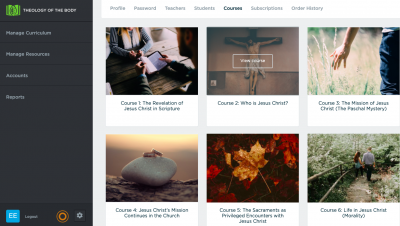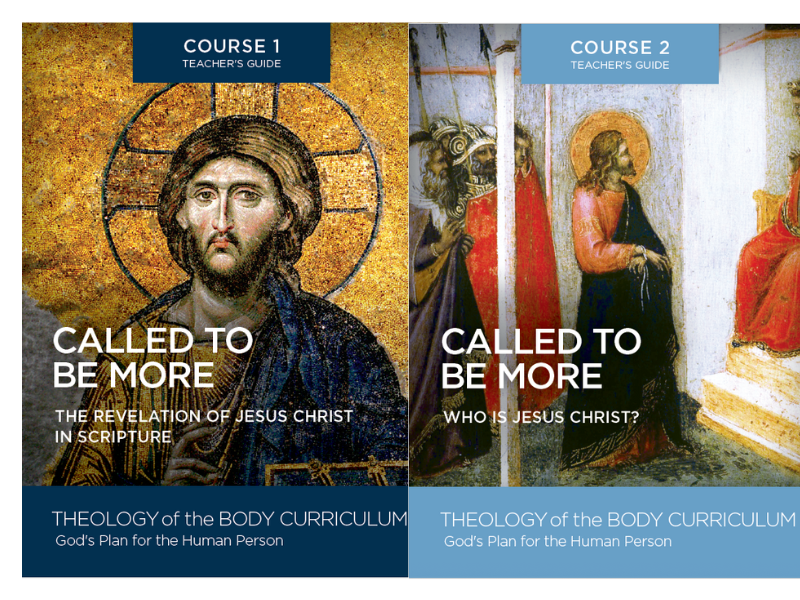
Called To Be More – Online Courses 1-8
Our teens are struggling to find their place in the world. If…
Newly revised & now offered in print copy for the first time, these Called to Be More Teacher’s Guides & Student Companion Books may be pre-ordered, starting with freshman year (9th grade). Course 1 Teacher’s Guides & Student Companion Books will ship in August 2025 & Course 2 in December. Ruah Woods will continue to publish Courses 3-8 in the next 2 years. We anticipate Courses 3 & 4 will be available in print in the summer of ’26.
Pope St. John Paul II’s Theology of the Body deepens our understanding of who the human person is, rooted in Jesus Christ (a concept known as theological anthropology). It is a lens through which students can learn who they are, where they are called and how to live a life of holiness and happiness.
Pope St. John Paul II liked to use the term “adequate anthropology,” which means a vision of the human person that is worthy of the human person. Learning the story of John Paul II’s life and path leading up to his weekly audiences delivering TOB is to realize that the Holy Spirit likely had a plan for these teachings to penetrate the very heart of the modern world.

Each teacher’s guide contains scripture connections, quotes from Man and Woman He Created Them, poignant classroom discussion questions, activities, and challenges to help students continue learning outside the classroom. This bundle may include the Course 1 (Aug 2025) & Course 2 (December 2025) newly revised & printed Teacher’s Guides.

Students use a Companion Books per semester for Courses 1-8 throughout each high school year. Course 1 (Aug 2025) & Course 2 (December 2025) explore dynamic, current & relevant Theology of the Body lessons, Lectio Divina in response to the dynamic promptings from the classroom. Each student book includes Theology of the Body tenets, reflections, and intentional assignments.

GOALS
Rather than provide measurable objectives for each lesson, the goals express the concepts that the author hopes the students will comprehend and grow in as they complete the lesson and beyond. The students should continually go deeper into the messages conveyed instead of checking off an intellectual task from the to-do list.
OPENING PRAYER
Called to Be More guides the students in prayer. The prayers provided for each lesson vary. Some are from Scripture, while others are the prayers of saints or even original prayers written specifically for the lesson. Like the Church’s practice of Lectio Divina (divine reading), we want to form our readers to not simply gloss over a prayer as words to mutter and then move on. We want to help them to rest in the words, listen to them and reflect on them. What this requires above all is a time of silence.
TESTIMONY
Similar to the saint biography, the video testimony for each lesson encourages students by affirming that there are others around the same age who are experiencing hopes, fears, dreams and struggles like their own. The purpose of both the testimony video and the saint biography is to attack the lie that one is alone, isolated and completely autonomous. Instead, our inherent relationality and the common bond of human experience are highlighted. The testimonies are not scripted and the speakers are not actors. The stories are real, and so too are the personalities, hesitancies and idiosyncrasies captured.
SAINT
As stated in the explanation of the testimony, one of the most common complaints of today’s young people is feeling isolated and lonely. To counter this experience, a biography of a saint (or other man or woman whose cause for canonization is underway) is available in many of the lessons to help students know that they are not alone. There are those who have already walked this road and are now in Heaven, interceding for them. The majority of the holy men and women chosen lived within the last century or two, highlighting that holiness is not a thing of the past. Sainthood is for today’s youth as well.
SUGGESTED ACTIVITIES
Each lesson includes opportunities for the educator to use hands-on activities to help students understand and to embody what they have learned. Many of these involve group work to encourage relationships and communication.
SUGGESTED VIDEO/MOVIE CLIPS
The video and movie clips suggested for each lesson allow students to see the truth of what they have learned lived out by others, often in surprising places. These are meant to be thought-provoking discussion starters, not time-fillers or merely trendy tools.
PERSONAL REFLECTION QUESTIONS
Students are provided with an opportunity to think and reflect on the material in a more personal capacity through the questions provided. For those who process through writing, these questions can be particularly helpful.
QUIZ
The quiz questions are not necessarily material that students should have memorized in the future. The questions are designed to gauge reading comprehension, listening skills and interest in the material.
FURTHER RESOURCES
For educators or students who would like to delve more deeply into the topics discussed, additional resources are provided.
BE MORE CHALLENGE
In an age of social media and increasing isolation, many young people are unsure of how to have a face-to-face conversation. How does one grow in the art of being human? These student challenges are meant to spark conversations, whether with friends, family or stranger, or to otherwise encourage young people in their ability to connect with others outside of the virtual world.
CONCLUSION
As you receive the beautiful message of the Theology of the Body as articulated in Called to be More, we pray that these seeds will bear great fruit in your own life, as well as in your students.
COURSE 1: THE REVELATION OF JESUS CHRIST IN SCRIPTURE (typically 9th Grade, 1st semester)
Lesson 1: Who Is Pope St. John Paul II?
Lesson 2: Why Does God Reveal Himself?
Lesson 3: How Does God Reveal Himself?
Lesson 4: Genesis 1–2
Lesson 5: Marital Imagery in Scripture
Lesson 6: Jesus Christ Reveals Man to Himself
Lesson 7: Prayer
COURSE 2: WHO IS JESUS CHRIST? (typically 9th Grade, 2nd semester)
Lesson 1: Jesus Christ and Revelation
Lesson 2: The Trinity
Lesson 3: Receiving Life as a Gift
Lesson 4: Love
Lesson 5: Sexual Difference: Visible Sign of Love
Lesson 6: Womanhood
Lesson 7: Manhood
Lesson 8: Friendship
Lesson 9: Suffering
Guiding teens to become who God created them to be
A NOTE TO EDUCATORS
Called to Be More has been prepared with great thought for several years, and it is an honor that you are planning to use these lessons with the high school students entrusted to your care. Before you begin, this serves as a brief introduction to the vision of the curriculum. The elements of Called to Be More that are different from many mainstream curricula have been structured with the intention of ensuring that both content and method authentically teach the Theology of the Body.
WHY A THEOLOGY OF THE BODY CURRICULUM?
The Theology of the Body is not the panacea to end catechetical deficits or personal struggles. Nevertheless, John Paul II once wrote in a letter to Henri de Lubac that the crisis of modernity involved a “degradation, indeed . . . a pulverization, of the fundamental uniqueness of each human person.”1 Called to Be More seeks to weave the “adequate anthropology” of the Theology of the Body into the U.S. Conference of Catholic Bishop’s (USCCB) Doctrinal Elements of a Curriculum Framework to give students a true “catechesis on human love,” thereby going to the root of so many of our societal struggles with faith and morality. The more deeply students understand who they are, created in God’s image and likeness, the more fruitful our catechesis on marriage and the family can be.
FOLLOWING THE USCCB’S DOCTRINAL ELEMENTS OF A
CURRICULUM FRAMEWORK
When we take a moment to survey our cultural landscape, it becomes apparent that today’s high school students have been formed by our culture with layers upon layers of misinformation, misunderstandings and presuppositions in thinking that are contrary to Catholic teaching. Consequently, in order to fully express the concepts of the Theology of the Body, students must be introduced to them in a gradual, successive, and logical way that engages their thinking skills and encourages them to question the definitions, understandings and logic that the world has taught them.
Simultaneously, because the Theology of the Body is a matter of an “adequate anthropology,” its themes underscore major points from every religion course in the USCCB’s Curriculum Framework. Even if one does not follow the framework, the major themes of Scripture, Christology, Sacraments, Morality, etc., remain the same. Integrating the Theology of the Body into each religion course serves two main purposes:
1. It allows the students to learn an adequate anthropology over time, with greater hope of the message becoming deeply imprinted on their hearts thus transforming their lives in significant ways.
2. It enables the students to see several themes united throughout their four years of high school religion: the covenantal love of God, the importance of the body and sexual difference, the true nature of love, the meaning of vocation, etc.
The way in which the lesson topics relate to one another is especially evident in the Scope and Sequence document provided in the Appendix. The ordering of individual courses and lessons can be rearranged when necessary, for which this outline of lesson topics is invaluable.
Outside of a traditional high school classroom, Called to be More can still be used for personal or communal study and growth. The format is easily adaptable to youth groups, college campus ministry and teacher or parent formation, among other ministries and programs.
What is Theology of the Body?
Theology of the Body (or TOB) is the basis of our religion curriculum and coursework. But we know that most Catholics don’t have a firm understanding of Theology of the Body yet. That’s why we want to guide you through it. TOB is St. John Paul II’s powerful glimpse of the human person – expressed in 129 separate audiences – revealing the beauty of God’s design for us. TOB helps us to understand how we were created, our identity in Christ, and our giftings, so that we may see ourselves and others the way God intended.
What is the best way to implement these fundamental teachings of what it means to be human according to God’s plan and purpose?
There are so many different ways that schools, diocese, homeschoolers and parishes have added in Theology of the Body to help cultivate a sacramental worldview. Please contact us at Ruah Woods 513 407-8672 or email curriculum@ruahwoods.org to form your students and teachers in the truth, beauty and goodness of Theology of the Body. We are on a mission to heal a wounded world — one heart and mind at a time.
Why the name, Called to Be More?
Called to Be More originally was the name of a teen-initiated vocations pilgrimage walk sponsored by Ruah Woods in 2011. As the high school curriculum project grew, it seemed a fitting name for a program rooted in the Theology of the Body that explores the dignity of the human person, the vocation to love and the meaning of life as a gift from God. In Jason Evert’s biography, Saint John Paul the Great: His Five Loves, former Swiss Guard Mario Enzler wrote in the forward that the late Holy Father often said, “Be more!”
Called to Be More also echoes the oft-quoted words of John Paul II from World Youth Day in Rome in 2000:
It is Jesus in fact that you seek when you dream of happiness; he is waiting for you when nothing else you find satisfies you; he is the beauty to which you are so attracted; it is he who provokes you with that thirst for fullness that will not let you settle for compromise; it is he who urges you to shed the masks of a false life; it is he who reads in your hearts your most genuine choices, the choices that others try to stifle. It is Jesus who stirs in you the desire to do something great with your lives, the will to follow an ideal, the refusal to allow yourselves to be grounded down by mediocrity, the courage to commit yourselves humbly and patiently to improving yourselves and society, making the world more human and more fraternal.
Each lesson includes a blend of different modules to accompany the educator’s style and the students’ learning patterns. What works for one group might not work for another. Every classroom is different because it is made of unique, unrepeatable persons. Every teacher is different, as is his or her relationship with the students. Therefore, the different modules aim to assist in a more personal experience of the material.

CUSTOMER REVIEWS